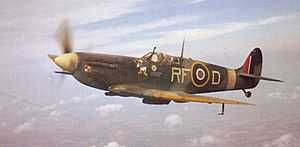RAF phonetic alphabet
- The RAF phonetic alphabet is a spelling alphabet, not a phonetic alphabet in the sense in which that term is used in academic fields such as phonetics. See the phonetic alphabet disambiguation page.
Following the take-up of radio, the British Royal Air Force (RAF) used a succession of radiotelephony spelling alphabets to aid communication. These have now all been superseded by the NATO phonetic alphabet.

These alphabets were used in phrases to emphasize or spell out an aircraft identification letter, e.g. "H-Harry", "G for George". In the RAF, each aircraft in a squadron was identified by a single letter. This single letter was not the multi-character aircraft serial number, which was painted on the tail. The serial number consisted initially of a single letter followed by four numbers, but as these variations ran out, the serial number consisted of two letters followed by three numbers, similar to motorcar licence plates of the time. The individual aircraft identification letter was painted on the side of the aircraft in large letters following the two-letter squadron designation code and the RAF roundel. This system uniquely identified an aircraft, because no squadron had more than 26 aircraft at the time.
The first spelling alphabet owes a lot to World War I Western Front "signalese" - the phonetic spelling used by signallers. Only "Ack", "Gee", "Emma", and "Esses" changed when the RAF radiotelephony spelling alphabet was adopted internationally. Possibly these were changed because the RAF radiotelephony spelling in phrases such as Ack-Ack: AA, anti-aircraft (fire), "ack emma" for AM, and "pip emma" for PM, had become common. New, unambiguous means of verbally communicating individual letters may have been sought. The original Royal Navy of World War I spelling alphabet differed more from the later NATO phonetic alphabet than the RAF radiotelephony spelling alphabet, with its use of the words "Apples" for "A", "Butter" for "B", "Duff" for "D", "Pudding" for "P", "Queenie" for "Q", "Tommy" for "T", "Vinegar" for "V", "Willie" for "W", "Xerxes" for "X", and "Yellow" for "Y.[1]
Notice to Airmen Number 107 of 1921 adopted the RAF radiotelephony spelling alphabet in use by the three armed services for civil aviation as well.[2]
Alphabets
| < 1921 – 1942[2][3] | 1942–1956 |
|---|---|
| Ack (?) Beer Charlie Don Edward Freddie George Harry Ink Johnnie King London Monkey Nuts 1 Orange Pip Queen Robert Sugar Toc Uncle Vic 2 William X-ray Yorker Zebra |
Able Baker Charlie Dog Easy Fox George How Item Jig King Love Mike Nan Oboe Peter Queen Roger Sugar Tare Uncle Victor William X-ray Yoke Zebra |
- 1 The choice of Nuts following Monkey is probably from "monkey nuts" = peanuts.
- 2 "Vic" subsequently entered the English language as the standard (Vee-shaped) flight pattern of three aircraft.
1956–present
In 1956 the NATO phonetic alphabet was adopted due to the RAF's wide commitments with NATO and worldwide sharing of civil aviation facilities.[4]
| < 1956 – Present |
|---|
| Alpha Bravo Charlie Delta Echo Foxtrot Golf Hotel India Juliett Kilo Lima Mike November Oscar Papa Quebec Romeo Sierra Tango Uniform Victor Whiskey X-ray Yankee Zulu |
See also
- Cockney alphabet
- Toc H - example of signalese carry-over.
- German phonetic alphabet
References
- ↑ Spelling alphabet
- ↑ 2.0 2.1 "Notice to Airmen", Flight (Flightglobal.com), 29 December 1921: 862, retrieved 2014-08-11
- ↑ Keesing's Contemporary Archives, Volume 4, Part 2, 1942
- ↑ "'Alfa Bravo' for R.A.F", Flight (Flightglobal.com), 13 January 1956: 63, retrieved 2014-08-11